tow VOLVO V60 2018 Owner´s Manual
[x] Cancel search | Manufacturer: VOLVO, Model Year: 2018, Model line: V60, Model: VOLVO V60 2018Pages: 406, PDF Size: 9.59 MB
Page 4 of 406
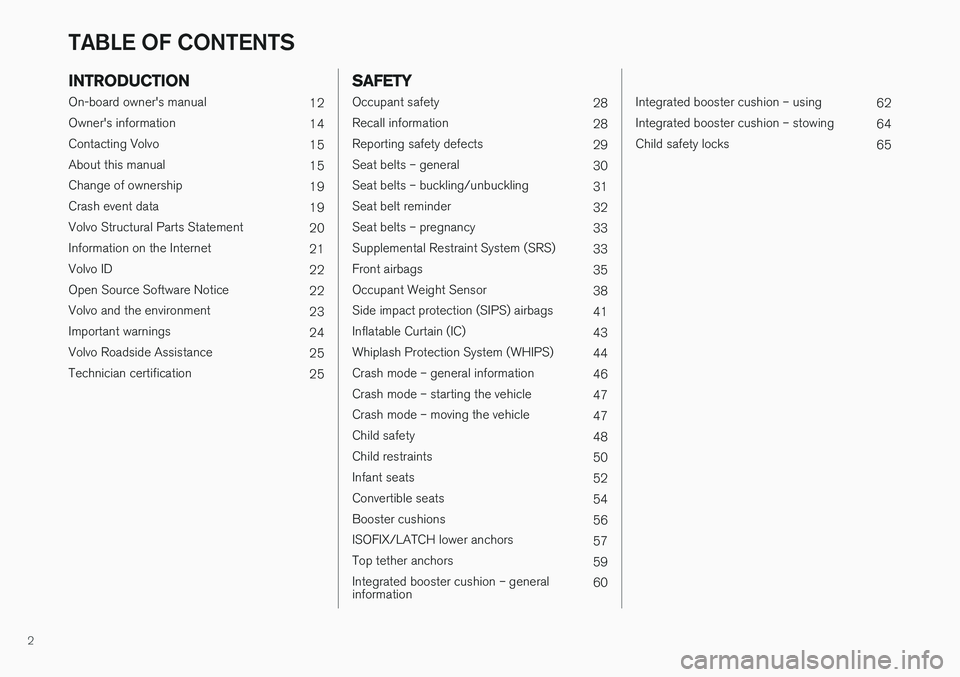
2
INTRODUCTION
On-board owner's manual12
Owner's information 14
Contacting Volvo 15
About this manual 15
Change of ownership 19
Crash event data 19
Volvo Structural Parts Statement 20
Information on the Internet 21
Volvo ID 22
Open Source Software Notice 22
Volvo and the environment 23
Important warnings 24
Volvo Roadside Assistance 25
Technician certification 25
SAFETY
Occupant safety28
Recall information 28
Reporting safety defects 29
Seat belts – general 30
Seat belts – buckling/unbuckling 31
Seat belt reminder 32
Seat belts – pregnancy 33
Supplemental Restraint System (SRS) 33
Front airbags 35
Occupant Weight Sensor 38
Side impact protection (SIPS) airbags 41
Inflatable Curtain (IC) 43
Whiplash Protection System (WHIPS) 44
Crash mode – general information 46
Crash mode – starting the vehicle 47
Crash mode – moving the vehicle 47
Child safety 48
Child restraints 50
Infant seats 52
Convertible seats 54
Booster cushions 56
ISOFIX/LATCH lower anchors 57
Top tether anchors 59
Integrated booster cushion – general information 60
Integrated booster cushion – using
62
Integrated booster cushion – stowing 64
Child safety locks 65
TABLE OF CONTENTS
Page 9 of 406

7
Brakes – symbols 278
Anti-lock braking system (ABS) 279
Brake lights 279
Emergency Brake Assistance (EBA) 279
Parking brake – general information 280
Parking brake – applying 281
Parking brake – releasing 281
Parking brake – symbols and messages 283
Driving through water 284
Engine and cooling system 284
Conserving electrical current 285
Before a long distance trip 285
Driving in cold weather 286
Refueling – fuel requirements 286
Refueling – octane rating 287
Refueling – opening/closing fuel filler door 289
Refueling – opening/closing fuel cap 290
Emission controls 290
Economical driving 291
Towing a trailer 292
Trailer Stability Assist (TSA) 294
Towing the vehicle 295
Towing eyelet 295
Towing by tow truck 296
WHEELS AND TIRES
Tires – general information300
Tires – storage and age 301
Tires – tread wear indicator 302
Tires – tire economy 302
Changing a wheel – direction of rotation 303
Changing a wheel – removing wheel 303
Changing a wheel – spare wheel 306
Changing a wheel – accessing the spare wheel 307
Changing a wheel – installing a wheel 307
Tire inflation – general information 308
Tire inflation – checking pressure 309
Tire specifications 310
Loading specifications 312
Loading specifications – load limit 312
Tire specifications – terminology 313
Tire specifications – Uniform TireQuality Grading 314
Snow chains 315
Snow tires/studded tires 316
Tire pressure monitoring - overview 316
Tire Monitor - introduction 317
Calibrating Tire Monitor 318
Tire Monitor status information 319
Tire Monitor – messages 319
Tire Pressure Monitoring System (TPMS) – general information320
Tire Pressure Monitoring System(TPMS) – changing wheels 321
Tire Pressure Monitoring System(TPMS) – recalibrating 322
Tire Pressure Monitoring System(TPMS) – activating/deactivating 322
Tire Pressure Monitoring System(TPMS) – messages 323
Tire sealing system * – general infor-
mation 324
Tire sealing system * – overview
325
Tire sealing system * – sealing a hole
327
Tire sealing system – checking infla-tion pressure 329
Tire sealing system * – inflating tires
329
Tire sealing system * – sealing com-
pound container 330
Page 36 of 406
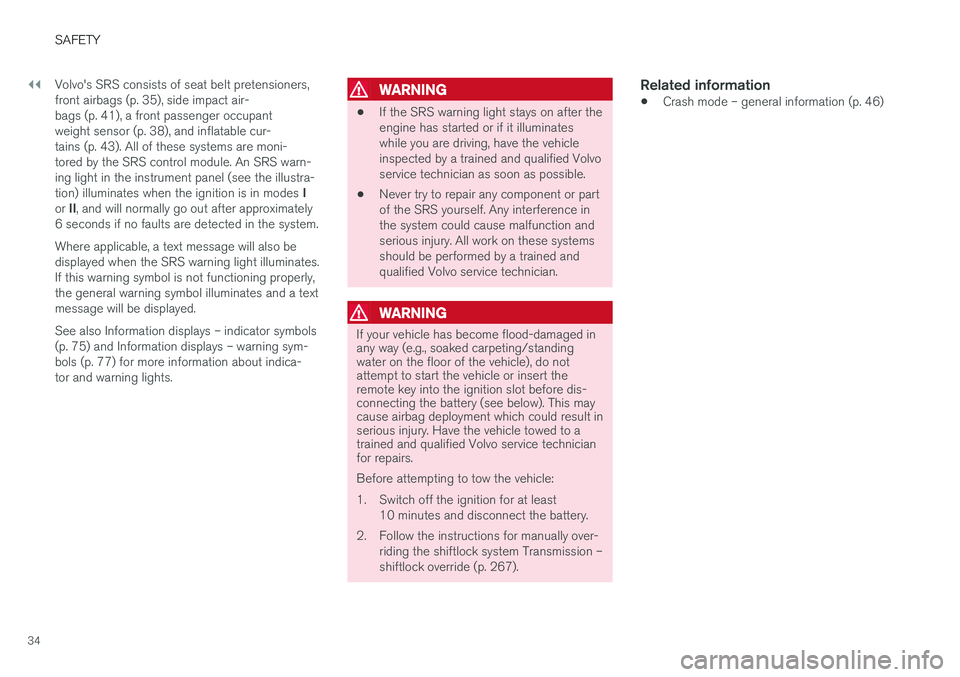
||
SAFETY
34Volvo's SRS consists of seat belt pretensioners, front airbags (p. 35), side impact air-bags (p. 41), a front passenger occupantweight sensor (p. 38), and inflatable cur-tains (p. 43). All of these systems are moni-tored by the SRS control module. An SRS warn-ing light in the instrument panel (see the illustra- tion) illuminates when the ignition is in modes
I
or II, and will normally go out after approximately
6 seconds if no faults are detected in the system. Where applicable, a text message will also be displayed when the SRS warning light illuminates.If this warning symbol is not functioning properly,the general warning symbol illuminates and a textmessage will be displayed. See also Information displays – indicator symbols (p. 75) and Information displays – warning sym-bols (p. 77) for more information about indica-tor and warning lights.
WARNING
• If the SRS warning light stays on after the engine has started or if it illuminateswhile you are driving, have the vehicleinspected by a trained and qualified Volvoservice technician as soon as possible.
• Never try to repair any component or partof the SRS yourself. Any interference inthe system could cause malfunction andserious injury. All work on these systemsshould be performed by a trained andqualified Volvo service technician.
WARNING
If your vehicle has become flood-damaged in any way (e.g., soaked carpeting/standingwater on the floor of the vehicle), do notattempt to start the vehicle or insert theremote key into the ignition slot before dis-connecting the battery (see below). This maycause airbag deployment which could result inserious injury. Have the vehicle towed to atrained and qualified Volvo service technicianfor repairs. Before attempting to tow the vehicle:
1. Switch off the ignition for at least
10 minutes and disconnect the battery.
2. Follow the instructions for manually over- riding the shiftlock system Transmission – shiftlock override (p. 267).
Related information
•Crash mode – general information (p. 46)
Page 38 of 406
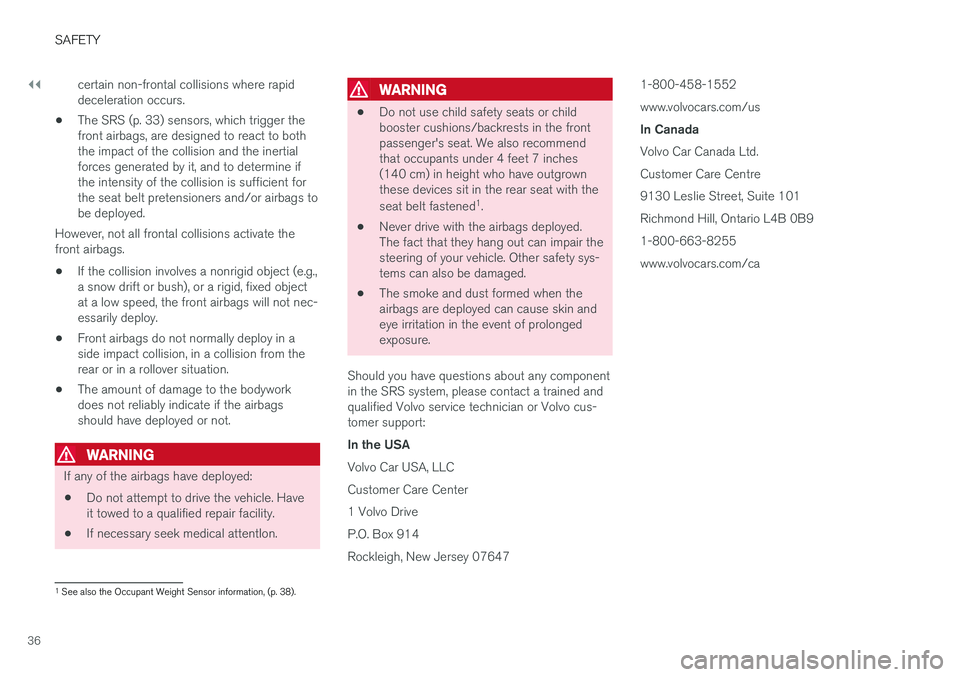
||
SAFETY
36certain non-frontal collisions where rapid deceleration occurs.
• The SRS (p. 33) sensors, which trigger thefront airbags, are designed to react to boththe impact of the collision and the inertialforces generated by it, and to determine ifthe intensity of the collision is sufficient forthe seat belt pretensioners and/or airbags tobe deployed.
However, not all frontal collisions activate thefront airbags.
• If the collision involves a nonrigid object (e.g.,a snow drift or bush), or a rigid, fixed objectat a low speed, the front airbags will not nec-essarily deploy.
• Front airbags do not normally deploy in aside impact collision, in a collision from therear or in a rollover situation.
• The amount of damage to the bodyworkdoes not reliably indicate if the airbagsshould have deployed or not.
WARNING
If any of the airbags have deployed:
• Do not attempt to drive the vehicle. Have it towed to a qualified repair facility.
• If necessary seek medical attentIon.
WARNING
•Do not use child safety seats or child booster cushions/backrests in the frontpassenger's seat. We also recommendthat occupants under 4 feet 7 inches(140 cm) in height who have outgrownthese devices sit in the rear seat with the seat belt fastened 1
.
• Never drive with the airbags deployed. The fact that they hang out can impair thesteering of your vehicle. Other safety sys-tems can also be damaged.
• The smoke and dust formed when theairbags are deployed can cause skin andeye irritation in the event of prolongedexposure.
Should you have questions about any componentin the SRS system, please contact a trained andqualified Volvo service technician or Volvo cus-tomer support: In the USA Volvo Car USA, LLC Customer Care Center1 Volvo DriveP.O. Box 914Rockleigh, New Jersey 07647 1-800-458-1552www.volvocars.com/us In Canada Volvo Car Canada Ltd. Customer Care Centre9130 Leslie Street, Suite 101Richmond Hill, Ontario L4B 0B91-800-663-8255www.volvocars.com/ca
1
See also the Occupant Weight Sensor information, (p. 38).
Page 39 of 406
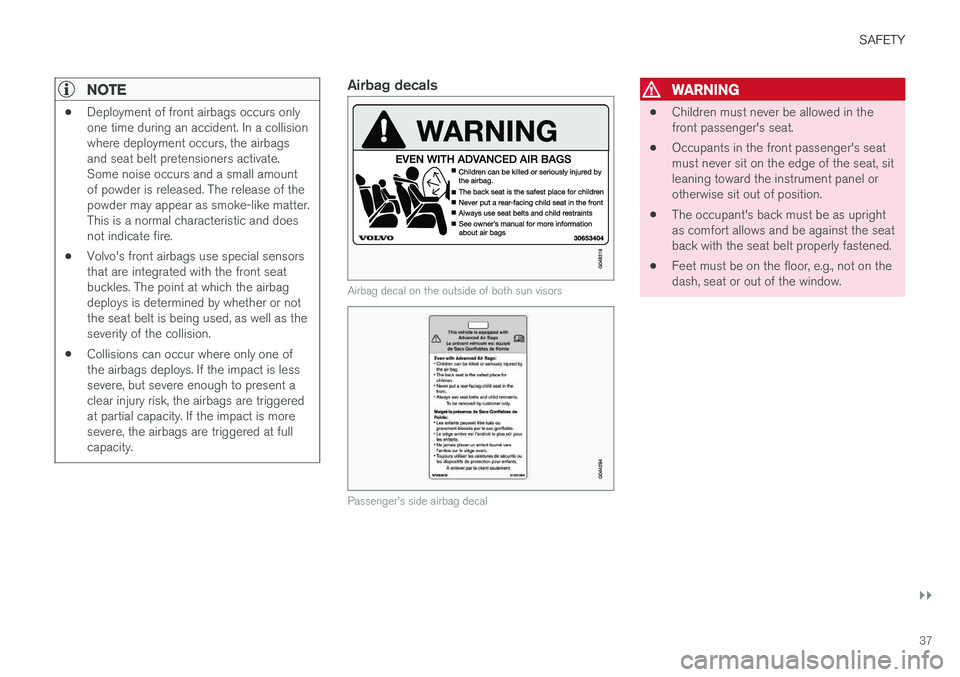
SAFETY
}}
37
NOTE
•Deployment of front airbags occurs only one time during an accident. In a collisionwhere deployment occurs, the airbagsand seat belt pretensioners activate.Some noise occurs and a small amountof powder is released. The release of thepowder may appear as smoke-like matter.This is a normal characteristic and doesnot indicate fire.
• Volvo's front airbags use special sensorsthat are integrated with the front seatbuckles. The point at which the airbagdeploys is determined by whether or notthe seat belt is being used, as well as theseverity of the collision.
• Collisions can occur where only one ofthe airbags deploys. If the impact is lesssevere, but severe enough to present aclear injury risk, the airbags are triggeredat partial capacity. If the impact is moresevere, the airbags are triggered at fullcapacity.
Airbag decals
Airbag decal on the outside of both sun visors
Passenger's side airbag decal
WARNING
• Children must never be allowed in the front passenger's seat.
• Occupants in the front passenger's seatmust never sit on the edge of the seat, sitleaning toward the instrument panel orotherwise sit out of position.
• The occupant's back must be as uprightas comfort allows and be against the seatback with the seat belt properly fastened.
• Feet must be on the floor, e.g., not on thedash, seat or out of the window.
Page 49 of 406
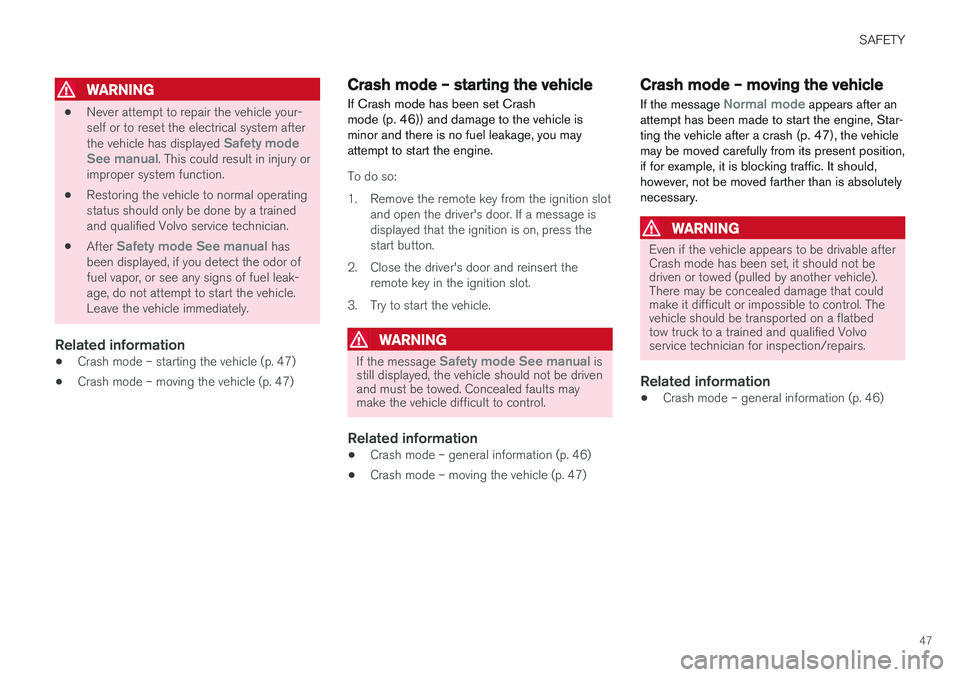
SAFETY
47
WARNING
•Never attempt to repair the vehicle your- self or to reset the electrical system after the vehicle has displayed
Safety mode
See manual. This could result in injury or
improper system function.
• Restoring the vehicle to normal operating status should only be done by a trainedand qualified Volvo service technician.
• After
Safety mode See manual has
been displayed, if you detect the odor of fuel vapor, or see any signs of fuel leak-age, do not attempt to start the vehicle.Leave the vehicle immediately.
Related information
• Crash mode – starting the vehicle (p. 47)
• Crash mode – moving the vehicle (p. 47)
Crash mode – starting the vehicle
If Crash mode has been set Crash mode (p. 46)) and damage to the vehicle isminor and there is no fuel leakage, you mayattempt to start the engine.
To do so:
1. Remove the remote key from the ignition slot and open the driver's door. If a message is displayed that the ignition is on, press thestart button.
2. Close the driver's door and reinsert the remote key in the ignition slot.
3. Try to start the vehicle.
WARNING
If the message Safety mode See manual is
still displayed, the vehicle should not be driven and must be towed. Concealed faults maymake the vehicle difficult to control.
Related information
• Crash mode – general information (p. 46)
• Crash mode – moving the vehicle (p. 47)
Crash mode – moving the vehicle
If the message
Normal mode appears after an
attempt has been made to start the engine, Star- ting the vehicle after a crash (p. 47), the vehiclemay be moved carefully from its present position,if for example, it is blocking traffic. It should,however, not be moved farther than is absolutelynecessary.
WARNING
Even if the vehicle appears to be drivable after Crash mode has been set, it should not bedriven or towed (pulled by another vehicle).There may be concealed damage that couldmake it difficult or impossible to control. Thevehicle should be transported on a flatbedtow truck to a trained and qualified Volvoservice technician for inspection/repairs.
Related information
• Crash mode – general information (p. 46)
Page 62 of 406

SAFETY
60•
Convertible seats (p. 54)
• Integrated booster cushion – general infor- mation (p. 60)
• ISOFIX/LATCH lower anchors (p. 57)
Integrated booster cushion – general information
The booster cushions are designed to raise the child higher so that the shoulder strap crossesover the child's collarbone, not over the neck.
Integrated two-stage booster cushion 2Volvo's optional integrated booster cushions are located in the outboard seating positions. Thesebooster cushions have been specially designedto help safeguard children in the rear seat. Theyshould be stowed (p. 64) (folded down into theseat cushion) when not in use. When using anintegrated booster cushion (p. 62), the childmust be secured with the vehicle's three-pointseat belt. If using a booster cushion does not result in proper positioning of the shoulder strap, then thechild should be placed in a properly secured childrestraint (see (p. 50) ). The shoulder belt mustnever be placed behind the child's back or underthe arm.
Correct seating position: the shoulder belt is across the collarbone
Incorrect seating position: the child's head is above the head restraint and the shoulder belt is not across thecollarbone
Before driving, check that:
2
Canada only: This cushion may be referred to as a built-in booster cushion.
Page 65 of 406
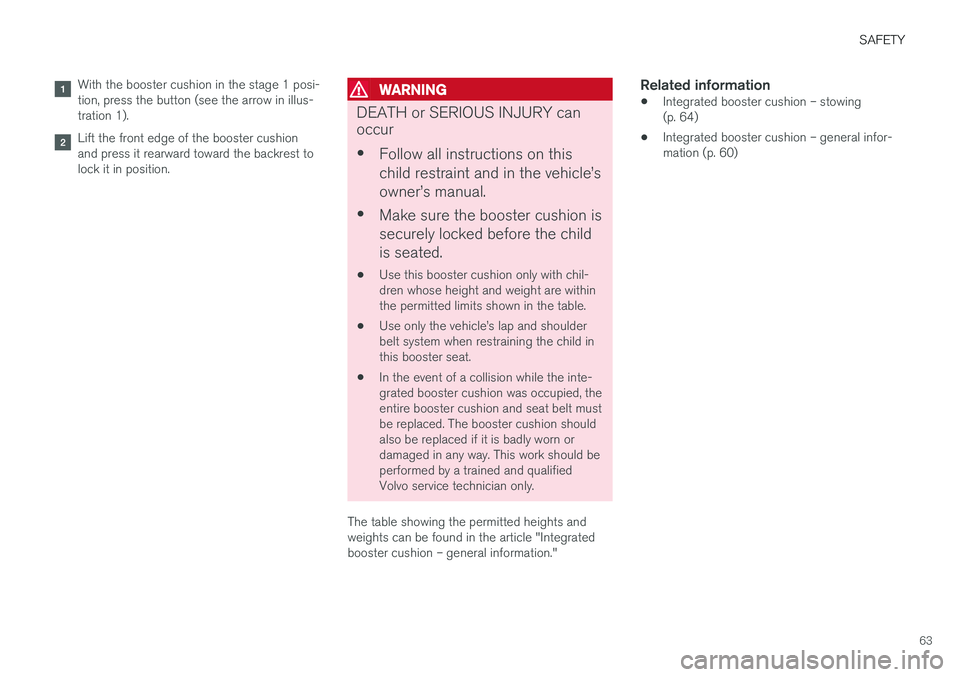
SAFETY
63
With the booster cushion in the stage 1 posi- tion, press the button (see the arrow in illus-tration 1).
Lift the front edge of the booster cushion and press it rearward toward the backrest tolock it in position.
WARNING
DEATH or SERIOUS INJURY can occur •Follow all instructions on this child restraint and in the vehicle
Page 66 of 406
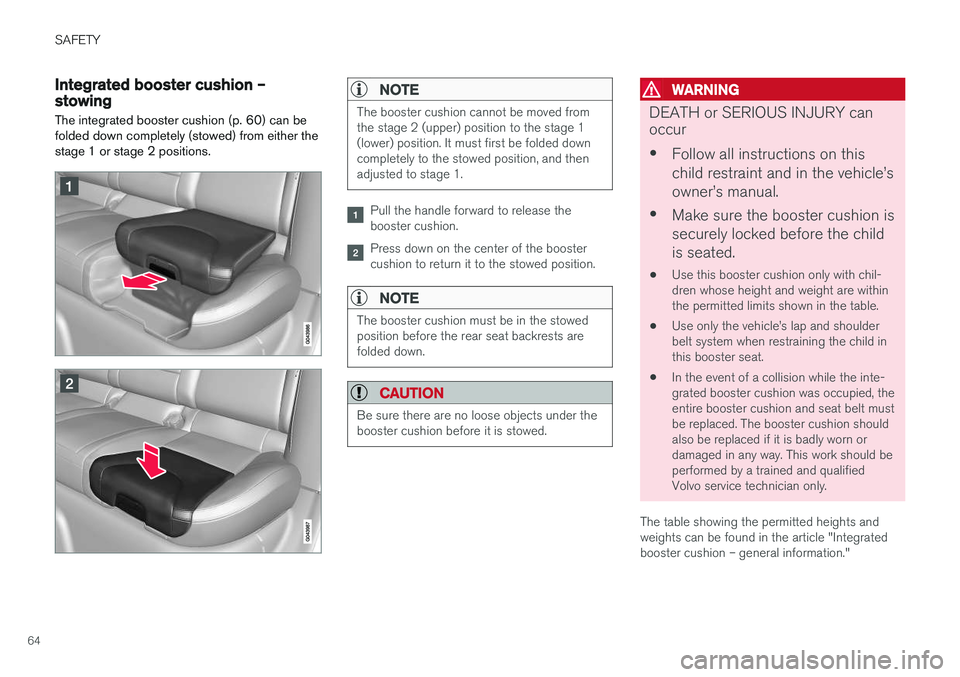
SAFETY
64
Integrated booster cushion – stowing
The integrated booster cushion (p. 60) can be folded down completely (stowed) from either thestage 1 or stage 2 positions.NOTE
The booster cushion cannot be moved from the stage 2 (upper) position to the stage 1(lower) position. It must first be folded downcompletely to the stowed position, and thenadjusted to stage 1.
Pull the handle forward to release the booster cushion.
Press down on the center of the booster cushion to return it to the stowed position.
NOTE
The booster cushion must be in the stowed position before the rear seat backrests arefolded down.
CAUTION
Be sure there are no loose objects under the booster cushion before it is stowed.
WARNING
DEATH or SERIOUS INJURY can occur • Follow all instructions on this child restraint and in the vehicle
Page 79 of 406

INSTRUMENTS AND CONTROLS
}}
77
Related information
•Information displays – introduction (p. 71)
• Information displays – warning symbols (p. 77)
Information displays – warning symbols
The warning lights alert the driver that an impor- tant function is activated or that a serious faulthas occurred.
Symbol Description
Low oil pressure A
Parking brake applied B
SRS airbags
Seat belt reminder
Generator not charging
Fault in the brake system
Warning symbol, read the text dis- played in the instrument panel
A
Certain engines do not use this symbol to indicate low oil pres- sure. On these models, a text message will be displayed on theinstrument panel instead, see Engine compartment – engine oil(p. 339).
B The symbol is Park only on models with the optional digital
instrument panel.
Low oil pressure
If the light comes on while driving, stop the vehi- cle, stop the engine immediately, and check theengine oil level. Add oil if necessary. If the oil level is normal and the light stays on after restart,have the vehicle towed to the nearest trained andqualified Volvo service technician.
Parking brake applied
This symbol flashes while the brake is being applied and then glows steadily when the parkingbrake has been set. See Parking brake – general information (p. 280) for more information about using the parkingbrake.
Airbags – SRS
If this light comes on while the vehicle is being driven, or remains on for longer than approxi-mately 10 seconds after the vehicle has beenstarted, the SRS system's diagnostic functionshave detected a fault in a seat belt lock or pre-tensioner, a front airbag, side impact airbag,and/or an inflatable curtain. Have the system(s)inspected by a trained and qualified Volvo servicetechnician as soon as possible. See Supplemental Restraint System (SRS) (p. 33) for more information about the airbag sys-tem.
Seat belt reminder
This symbol comes on for approximately 6 sec- onds if the driver has not fastened his or her seatbelt.
Generator not charging
This symbol comes on during driving if a fault has occurred in the electrical system. Contact anauthorized Volvo workshop.